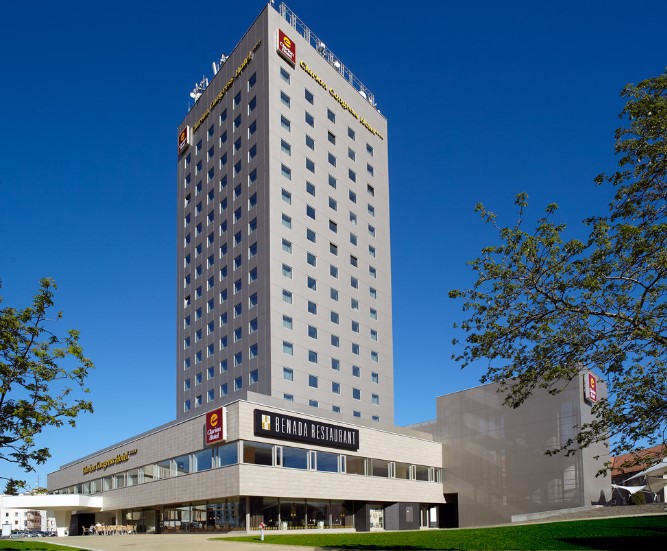


ChessBase 17 - Mega package - Edition 2024
It is the program of choice for anyone who loves the game and wants to know more about it. Start your personal success story with ChessBase and enjoy the game even more.
The Czech Republic has not been hit as hard by the global corona pandemic as other countries, so the restrictions to prevent infections have more or less been suspended by now. For several weeks already games of the Czech Chess Leagues have been taking place, while last week the first international closed tournament for GMs and IMs amid the crisis kicked off in České Budějovice.
České Budějovice or Budweis, as the town is called in German, was founded in the middle of the 13th century by Czech king Premysl Otakar II and is the largest town in the South Bohemian region. A large square is placed in the centre of town — it is named after the founder and is reminiscent of a chessboard. The large area is optically divided into smaller squares, although there are ten per side, not eight. The Samson Fountain is located in the middle of the square.
With a little imagination, the Clarion Hotel, located on an arterial road south of the city, also reminds us of the game of chess. The building is in fact a high, somewhat unadorned construction.

 The name of the town in German, Budweis, surely rings a bell for beer lovers, as the local brewery Budějovický Budvar has been producing a style highly appreciated by experts on this subject, the “Budweiser”, since 1895. When it was founded, the Czech brewery competed with the German brewery Budweis and its Budweiser Bürgerbräu, which existed since 1795. Around 1870, emigrants from České Budějovice took the recipe to the United States. Since 1876, the American brewery Anheuser-Busch, founded by Eberhard Anheuser and continued by his son-in-law Adolf Busch, based in St. Louis, has also been brewing a lager beer under the brand name Budweiser.
The name of the town in German, Budweis, surely rings a bell for beer lovers, as the local brewery Budějovický Budvar has been producing a style highly appreciated by experts on this subject, the “Budweiser”, since 1895. When it was founded, the Czech brewery competed with the German brewery Budweis and its Budweiser Bürgerbräu, which existed since 1795. Around 1870, emigrants from České Budějovice took the recipe to the United States. Since 1876, the American brewery Anheuser-Busch, founded by Eberhard Anheuser and continued by his son-in-law Adolf Busch, based in St. Louis, has also been brewing a lager beer under the brand name Budweiser.
In 1907, a very complicated trademark dispute arose between the breweries in the US and in České Budějovice regarding the rights to use the name "Budweiser" in individual countries and on different continents. The dispute continues to this day, and over the years has been split into over 120 individual proceedings. At present, the Czech brewery leads the competition with the greater number of won proceedings.
The closed GM Tournament in České Budějovice was organized by the local ‘Queen Chess Club’. The tournament was held with ten players, with five of them representing the Czech Republic and four of them coming from neighbouring countries — Austria, Hungary and Germany (two). Hannes Stefansson from Iceland represented Scandinavia.
German grandmaster Alexander Donchenko was the Elo favourite and more than lived up to this role as he led the event from start to finish. Czech GM Peter Michalik was able to keep up the pace for quite a while, however. Going into the last round, Donchenko had a half point advantage over his closest chasers.
Donchenko knew that a draw in round 9 would most likely be enough to win the tournament, but the young German grandmaster put his foot down and finished the tournament with a win with the black pieces.
The Fashionable Caro-Kann Vol.1 and 2
The Caro Kann is a very tricky opening. Black’s play is based on controlling and fighting for key light squares. It is a line which was very fashionable in late 90s and early 2000s due to the successes of greats like Karpov, Anand, Dreev etc. Recently due to strong engines lot of key developments have been made and some new lines have been introduced, while others have been refuted altogether. I have analyzed the new trends carefully and found some new ideas for Black.
White had more or less sacrificed his d-pawn and was now looking for compensation. 15.Bf1 Rxe3+ [Even after the objectively better 15...Rd7 16.h4 Bd5, Black is better with his extra pawn.]
16.fxe3 Bd5 17.Kf2 fxg5 [This gives Black two pawns for the exchange.]
18.Bg2 e6 19.Nd2 Bxg2 20.Kxg2 Ne5 21.Nf3 Nc4 [Better than the exchange on f3, which helps White.] 22.Kf2 [22.Nxg5 Rg8] 22...Rg8
23.b3 [Weakening the pawn on c3. After 23.e4, Black cannot capture on b2, as that would open a file for the white rooks — 23...Nxb2 [Better is 23...g4] 24.Rab1 Nd3+ 25.Ke3 c4 26.Rxb7] 23...Nd6 24.Nd2 [Otherwise Ne4.] 24...Bg7 25.Rac1 Ke7 26.c4 f5 27.Rg2 Be5 28.Nf3 Bf6 29.Nd2 Be5 30.b4 [White would like to open lines for his heavy pieces.] 30...Rc8 31.bxc5 Rxc5 32.Kf3 Kf6 33.Ke2 b6 34.Rhg1
Fighting against the Caro-Kann with the Advance Variation
The Caro-Kann Defence is one of the most solid replies for Black after 1.e4. Bologan's choice of the Advance Variation for White is because of the complex strategical play in which White has a long-term space advantage.
34...Rc8 [Black keeps his cool.] 35.Rgd1 Bb2 36.Rc2 Ba3 37.Nf3 g4 [After the hasty 37...Nxc4 38.Rd3 Black’s pieces would stand clumsily and he would lose some of his advantage.] 38.hxg4 hxg4 39.Nd2 [39.Nd4 Rh8]
39...Rh8 40.Nf1 Bc5 41.Ke1
41...Ne4 [Total domination.] 42.Rd7 Rh1 [White resigned as the threat of Ng3 is unstoppable.] 0-1
The Caro-Kann Defence has now completely changed its reputation. What used to be a peaceful defence has become a killer weapon.